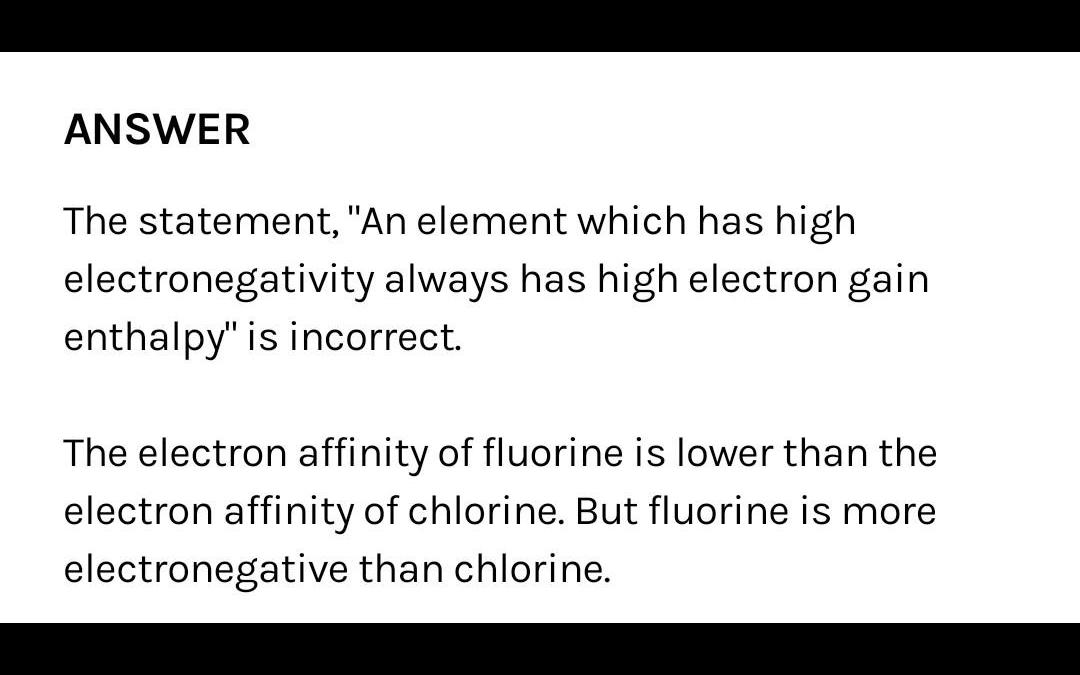Time management is very much important in IIT JAM. The eduncle test series for IIT JAM Mathematical Statistics helped me a lot in this portion. I am very thankful to the test series I bought from eduncle.
Nilanjan Bhowmick AIR 3, CSIR NET (Earth Science)Shib Sagar posted an Question
- IIT JAM
- Chemistry (CY)
Explain the answer with solution
(a) NPBAA Bond distance (C-H) in CH, is x and that of (Si -H) in SiH, is y. C-Si bond is Z A Calculate covalent radii of H atom ignoring the electronegativity difference (D) TN (s) X+y-2 2 X+y 2 (d) (a) (b) 2 2 Which of the following is incorrect (a) An element which has high electronegativity always has high electron gain en- thalpy (b) Electron gain enthalpy is the property of an isolated atom (c) Electronegativity is the property of bonded atoms. (d) Both electronegativity and electron gain enthalpy are usually directly related to nuclear charge. uL: ftho f11owina snecies of Mn has lowest electronegativity? 79.
- 0 Likes
- 5 Comments
- 0 Shares
-
![comment-profile-img]() >
>
-
Suman Kumar
![best-answer]()
Flourine due to small in size it has low eletron gain enthalpy. Addition of eletron cause repulsion due to lower size.
![eduncle-logo-app]()
So Statement A is incorrect. As flourine is most eletronegative but has less eletron gain enthalpy
![eduncle-logo-app]()
question no 78 pz explain sir
![eduncle-logo-app]()
ok
![eduncle-logo-app]()
Answer is option B shib ?
![eduncle-logo-app]()
please respond
![eduncle-logo-app]()
See this Shib
![eduncle-logo-app]()
please ask if you don't get anything 🙏
-
![comment-profile-img]() >
>
Priyanshu kumar
option A is incorrect... as you know electron gain enthalpy is the property of isolated atom... Electronegativity is tendency of element to attract bonded pair of electrons towards itself...and both EN and EgH is the property related to nuclear charge... so all the last three options are correct...
![cropped9205355623559952354.jpg]()
![eduncle-logo-app]()
got it shib?
![eduncle-logo-app]()
please accept the answer if you got it😊🙏
![eduncle-logo-app]()
give focus on exception case shib...generally quest. asked from exception part..as see you know down the group the electron gain enthalpy becomes less negative so according to this F have more negative electron gain enthalpy than chlorine but as in F the electron added to 2p orbital and in chlorine electron added to 3p orbital..so on case if F due to small size of 2p orbital..inter electronic repulsion is experienced but in case of chlorine 3p orbital size is larger than 2p...so less repulsion experienced..so that's why chlorine has more negative electron gain enrhalpy than fluorine....
![eduncle-logo-app]()
question no 78 pz explain
![eduncle-logo-app]()
i have attached the answer of 78 pls check it😊
-
![comment-profile-img]() >
>
Dinesh khalmaniya 1
hope this will help you 🙏🙏🙏🙏
-
![comment-profile-img]() >
>
Dinesh khalmaniya 1
The statement, "An element which has high electronegativity always has high electron gain enthalpy" is incorrect. The electron affinity of fluorine is lower than the electron affinity of chlorine. But fluorine is more electronegative than chlorine.
![eduncle-logo-app]()
please accept the answer if you got it 🙏🙏🙏
![eduncle-logo-app]()
got it??
![eduncle-logo-app]()
option A is incorrect
![eduncle-logo-app]()
question no 78 pz explain
Do You Want Better RANK in Your Exam?
Start Your Preparations with Eduncle’s FREE Study Material
- Updated Syllabus, Paper Pattern & Full Exam Details
- Sample Theory of Most Important Topic
- Model Test Paper with Detailed Solutions
- Last 5 Years Question Papers & Answers
Sign Up to Download FREE Study Material Worth Rs. 500/-










 >
>



 >
>







Priyanshu kumar Best Answer
check shib for 78...option B is correct
please mark the answer if it helps😊🙏
have you check this shib??
please respond shib😊